How To Get Rid Of Spider Mites On Cannabis Plants: Identify, and Solutions
Spider mites are tiny pests that can infest plants cannabis and cause serious damage. They are not actually spiders but belong to the same class of arachnids, and feed on the plant’s sap by piercing the leaves and sucking out the nutrients.
In this blog post, we will explain what spider mites are, how to identify them, how they damage cannabis plants, and how to get rid of them effectively. We will also share some tips on how to prevent spider mite infestations and keep your plants healthy and happy.
What is Red Spider Mites?
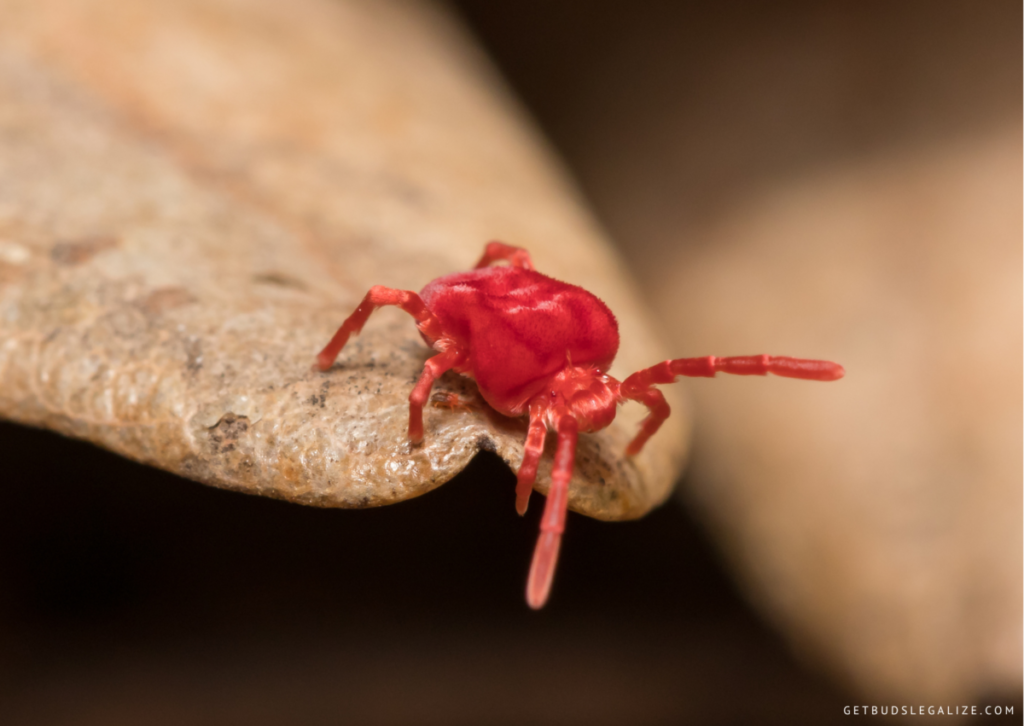
Red spider mites are one of the most common types of bugs that affect marijuana plants. They are also known as two-spotted spider mites or Tetranychus urticae. They are very small, about 0.4 mm long, and have eight legs. They are usually red or orange in color, but can also be green, yellow, or brown depending on their diet and life stage. Spider mites can also survive for long periods without food or water, making them very hard to eradicate.
Spider Mite Life Cycle
Spider mites have four phases in their life: egg, larva, nymph, and adult. The eggs are laid on the underside of the leaves and hatch in about three days. The larvae have six legs and feed on the plant for about five days before molting into nymphs.
The nymphs have eight legs and go through two more molts before becoming adults. The adults can live for two to four weeks and lay up to 20 eggs per day.
Spider mites thrive in hot and dry conditions. They can reproduce very quickly and form large colonies that cover the leaves with fine webs. They can also spread from plant to plant by wind or by contact.
How to Spot Spider Mites on Plants?
Spider mites on cannabis plants are very difficult to see with the naked eye because of their small size and color. They often blend in with the plant’s foliage or soil. The best way to spot them is by using a magnifying glass or a microscope. You can also shake a leaf over a white paper or a plate and look for tiny moving dots.
Spider mites have oval-shaped bodies with two dark spots on their back. These spots are actually accumulations of their body waste. They also have two pairs of eyes and a mouthpart that resembles a needle. They use this mouthpart to pierce the plant cells and suck out the sap.
What Are the First Signs of a Spider Mites Infestation?
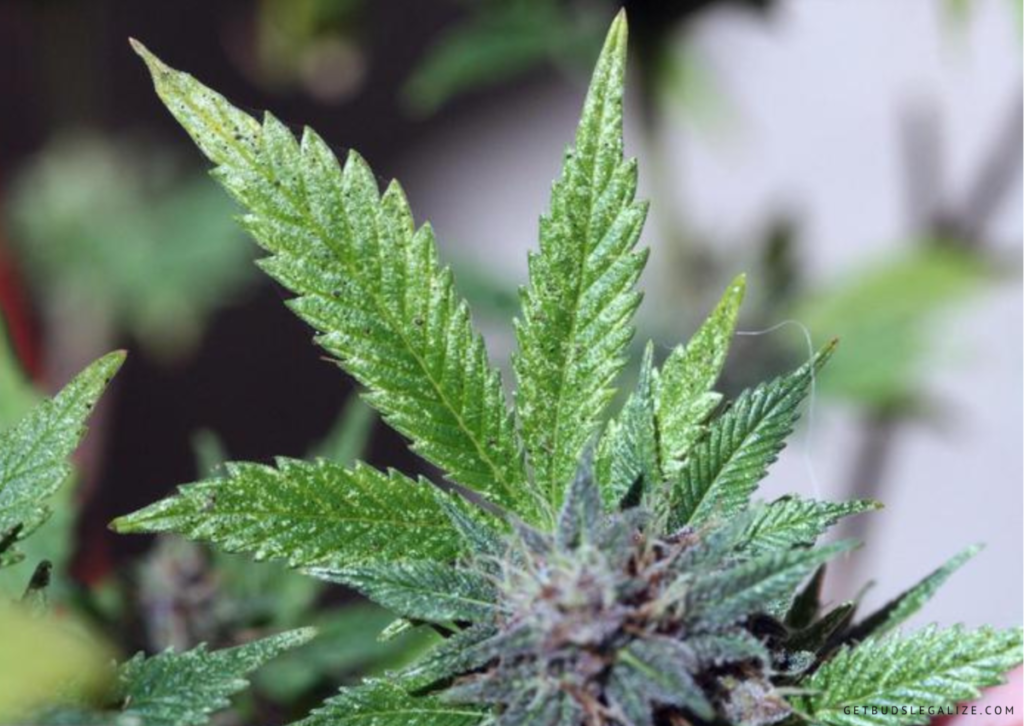
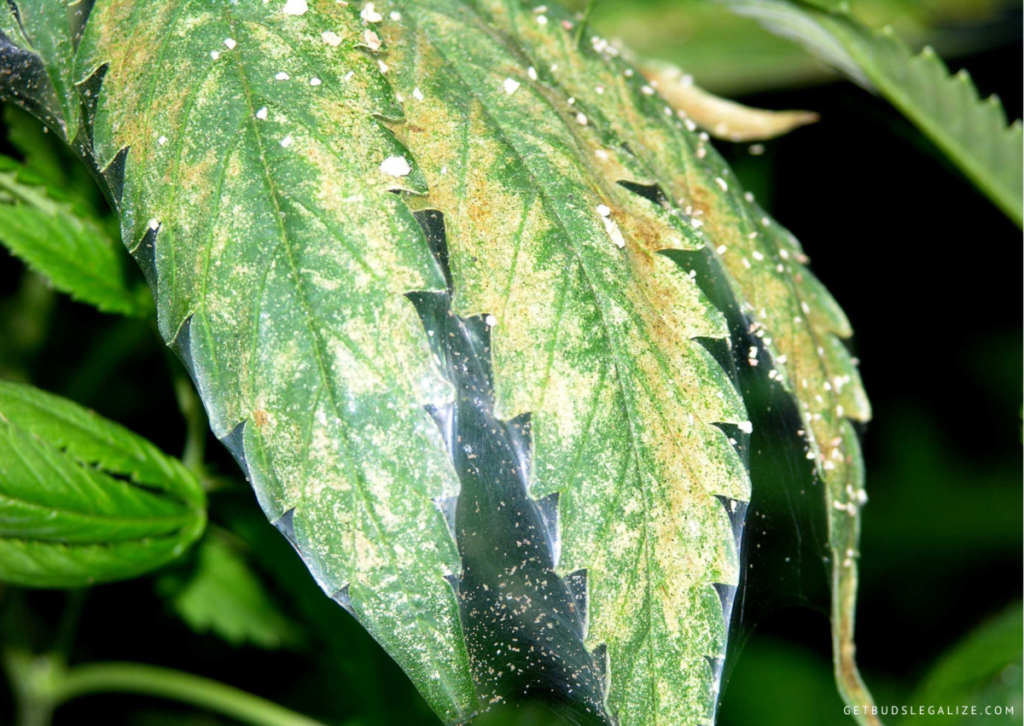
There are several signs that indicate that your marijuana plants have been infested by spider mites. Some of them are:
- Yellow spots or speckles on leaves: These are caused because they feed on plant cells and drain them of chlorophyll.
- Browning or curling of leaves: This is the result of loss of water and nutrients due to the damage they cause.
- Drooping or wilting of the plant: This is a sign of severe stress and dehydration caused by the spider mite infestation.
- Webbing on the leaves or stems: This is a clear indication of their presence in your plants. These webs protect them from predators and environmental factors. They also help them move around and lay eggs. The webs can be seen as white or grayish patches on the leaves or stems.
- Visible spider mites or eggs on the plant’s surface: You can use a magnifying glass or a microscope to confirm their presence.
What Does Spider Mite Damage Look Like?
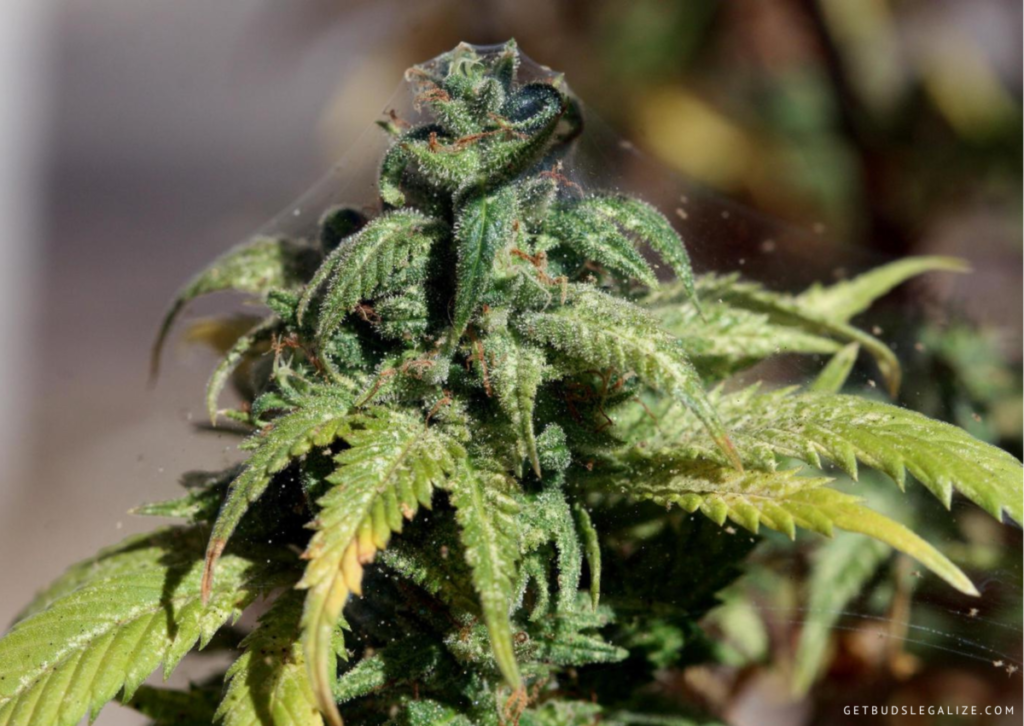
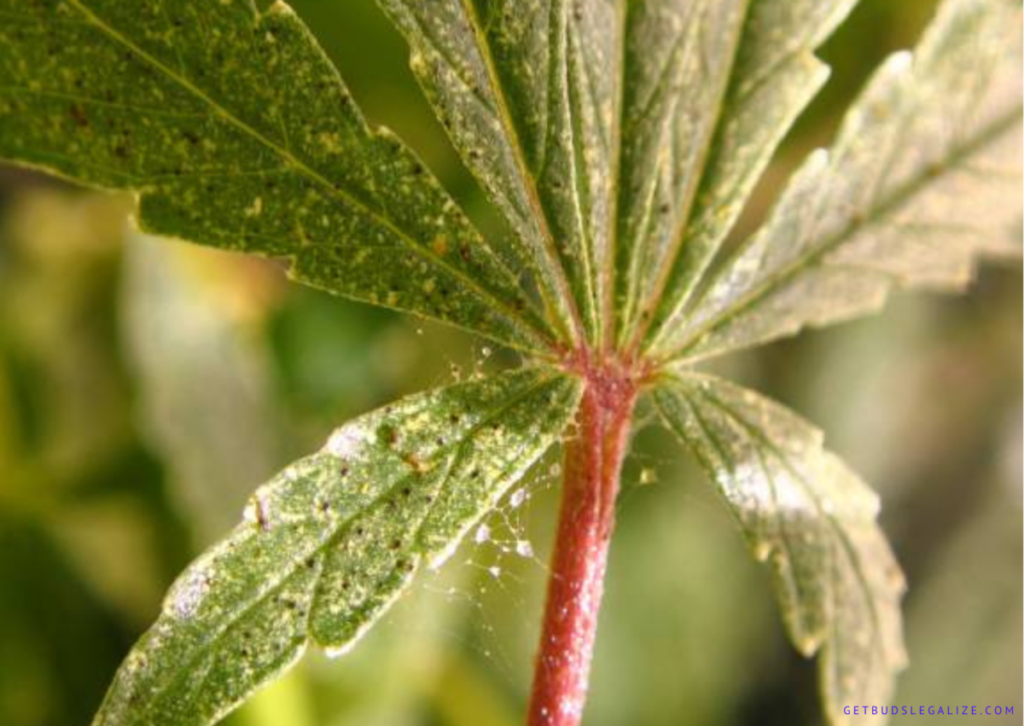
The damage they cause can vary depending on the severity of the infestation and the type of cannabis plant. Some strains may be more resistant or susceptible to mite attack than others. However, some common symptoms you may experience are:
- Reduced growth rate and yield: They can stunt the growth and development of your weed plants by depriving them of essential nutrients and water.
- Reduced potency and flavor: They can affect the quality and quantity of your weed buds by damaging the trichomes and terpenes that give them their aroma and effects.
- Increased risk of mold and diseases: They can weaken your plants’ immune system and make them more vulnerable to fungal infections and bacterial diseases.
- Reduced aesthetic appeal: They can ruin the appearance of your plants by making them look sickly, discolored, and covered in webs.
How to Get Rid of Red Spider Mites During the Vegetative Stage
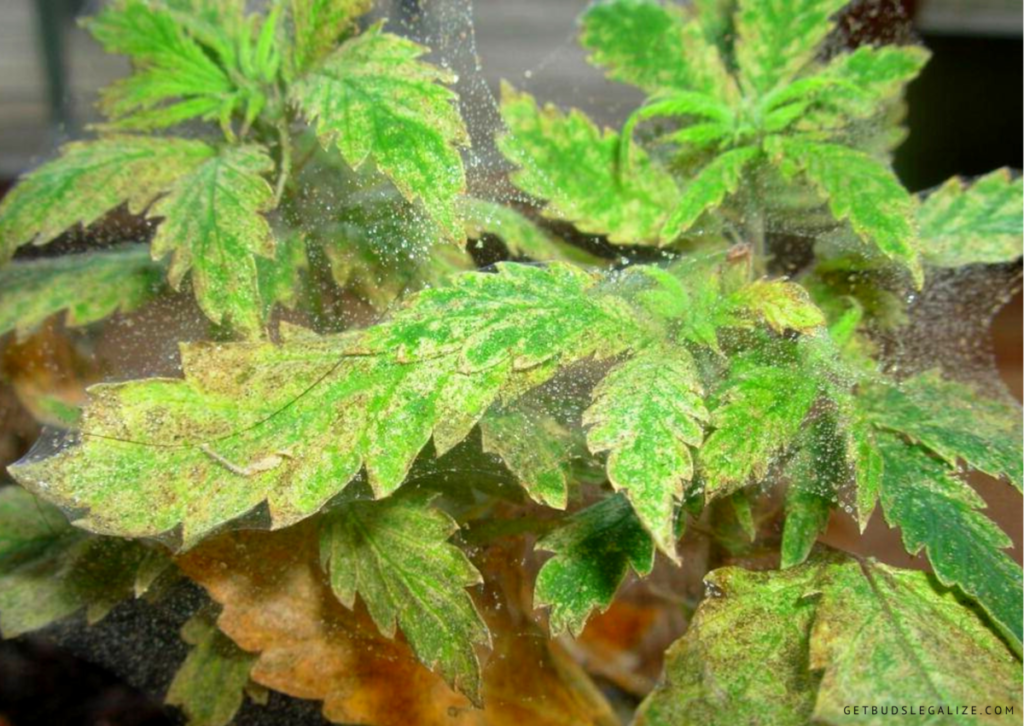
If you notice any spider mites on your weed during the vegetative stage, you need to act fast and eliminate them as soon as possible. You can do this by:
1. Pruning any infected leaves or branches and disposing of them in a sealed bag.
2. Spray your plants with a natural miticide such as oil of neem, rosemary oil, or peppermint oil. These oils can kill the spider mites and disrupt their reproduction cycle. You should spray your plants every three days until you see no more signs of spider mites.
3. Introducing natural predators such as ladybugs, lacewings, or predatory mites. These insects can feed on spider mites and reduce their population. You can buy them online or from a local garden center.
4. Increasing the humidity in your grow tent or room. Spider mites hate high humidity and will become less active and more vulnerable to miticides.
How to Get Rid of Spider Mites During Flowering Stage
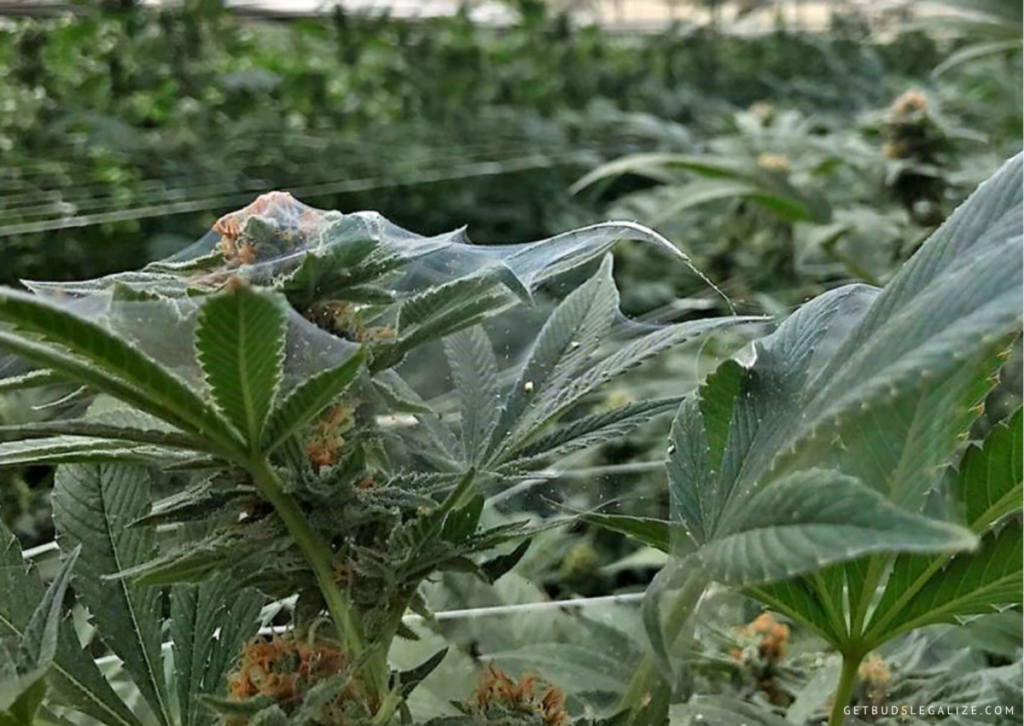
Spider mites on cannabis plants can be especially problematic during the flowering stage. They can affect the development and potency of your buds and make them less appealing for consumption.
If you notice them during flowering, you should avoid using harsh chemical pesticides or acaricides that can leave residue on your buds. Instead, you should use organic methods such as:
1. Trimming any infected buds or colas and disposing of them in a sealed bag.
2. Spray your plants with a diluted solution of hydrogen peroxide (H2O2): This can kill them and their eggs without harming your buds. You should spray your plants once a week until you see no more signs of spider mites.
3. Applying diatomaceous earth (DE) on your plants and soil: DE is a natural substance that consists of fossilized algae shells. It can dehydrate and kill red spider mites by piercing their exoskeletons. You should apply DE every few days until you see no more signs of them.
How to Get Rid of Spider Mites on Buds at Time of Harvest
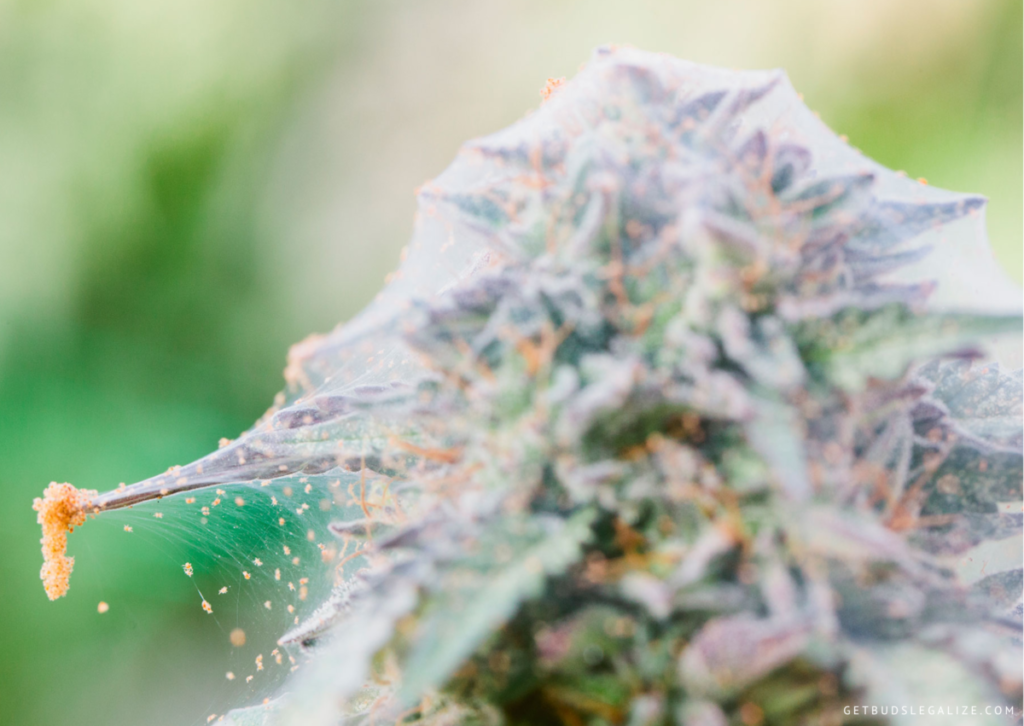
If you notice spider mites on your buds when you are ready to harvest, you need to act fast to save your crop. Here are some possible solutions:
1. Cut off the affected buds and discard them. This is the most drastic option, but it may be necessary if the infestation is severe and widespread. You don’t want to risk contaminating the rest of your harvest with spider mites or their eggs.
2. Wash the buds with water and hydrogen peroxide. This can help remove some of the spider mites and their webs, as well as prevent mold and bacteria growth. You can use a spray bottle or a bucket to gently rinse the buds with a solution of 1 part hydrogen peroxide and 9 parts water. Then, let them dry thoroughly before curing.
3. Freeze the buds for a few days. This can kill any remaining spider mites or eggs that may have survived the washing process. You can place the buds in a freezer bag or a glass jar and store them in the freezer for at least 72 hours. Then, let them thaw slowly before curing.
4. Use natural predators or beneficial insects. This is a more eco-friendly and long-term solution, but it may not be feasible if you are harvesting indoors or in a hurry. You can introduce predatory mites, ladybugs, lacewings, or other insects that feed on spider mites and help control their population. You can buy them online or from a local garden center.
5. Use a handheld vacuum cleaner on low power to suck the mites off your plants and buds. Be gentle and avoid damaging the buds. You can also prune the infected leaves and discard them in a sealed bag.
6. Use organic sprays that contain neem oil or other essential oils. These sprays can kill the mites and prevent them from laying eggs. However, you should avoid spraying your buds directly, as this can affect their flavor and quality. Instead, spray the leaves and stems of your plants, and wash your buds thoroughly before drying and curing them.
How to Prevent Spider Mites in Grow Room Naturally
There are several natural ways to prevent them from attacking your plants. Here are some of them:
1. Apply Trifecta Crop Control as a preventative. This is a natural product that contains essential oils and food-grade ingredients that repel and kill red mites and other pests. It also boosts the plant’s immune system and prevents fungal diseases. You can spray it on your plants once a week or as needed.
2. Quarantine new plants. Before introducing any new plants to your grow room, inspect them carefully for any signs of spider mites or other pests. Isolate them for at least two weeks and treat them with Trifecta Crop Control or another natural pesticide if necessary.
3. Use beneficial bugs. Some insects, such as ladybugs, predatory mites, lacewings, and pirate bugs, can help you control them by feeding on them and their eggs. You can buy these beneficial bugs online or from a local garden center and release them in your grow room.
4. Minimize plant stress. Spider mites are more likely to attack weak and stressed plants, so make sure you provide your plants with optimal growing conditions. Avoid overwatering, underwatering, overfeeding, underfeeding, or exposing them to extreme temperatures or light levels.
5. Regulate the humidity and temperature. Spider mites thrive in hot and dry environments, so keep your grow space’s temperature below 85°F (29°C) and humidity above 50%. You can use fans, humidifiers, dehumidifiers, air conditioners, or heaters to achieve this. You can also mist your plants with water occasionally to deter spider mites.
By following these natural methods, you can prevent spider mites from ruining your cannabis plants and enjoy a healthy and bountiful harvest.
Spider Mites on Cannabis Plants - FAQs
To get rid of spider mites, you need to act fast and use effective methods. Here are some steps you can take to eliminate them from your cannabis plants:
- Identify the infestation. Look for signs of spider mites on your plants, such as webbing, yellowing, curling, or dropping leaves. You can also use a magnifying glass to spot the mites themselves, which are usually red, yellow, or green.
- isolate the affected plants. If you have multiple cannabis plants, separate the ones that have spider mites from the rest. This will prevent the mites from spreading to other plants and make it easier to treat them.
- Remove the infected leaves. Use a pair of scissors or a razor blade to cut off the leaves that have spider mites or webbing on them. Dispose of them in a sealed bag or burn them to avoid re-infestation.
- Spray the plants with a miticide. A miticide is a chemical that kills spider mites and their eggs. You can buy a ready-made miticide from a garden store or make your own using natural ingredients, such as oil of neem, rosemary oil, or garlic. Follow the instructions on the label or recipe and spray your plants thoroughly, covering both sides of the leaves and stems.
- Repeat the treatment. Depending on the severity of the infestation and the type of miticide you use, you may need to spray your plants several times over a period of weeks. Monitor your plants closely and look for any signs of spider mites returning. If you see any, repeat the treatment until they are gone.
Spider mites are one of the most frequent and troublesome pests that can affect cannabis plants. These tiny creatures feed on the sap of the plant, leaving behind yellow or white spots, webbing, and eggs. They can multiply rapidly and cause severe damage to the plant’s health and yield if not controlled.
Spider mites can be found in indoor and outdoor cannabis gardens, especially in dirty or dusty environments. They prefer warm and dry conditions, and can easily spread from one plant to another by wind or contact.
To prevent and control spider mites, when you are growing cannabis you can use natural methods such as:
- Washing the plants with a strong jet of water with a low pH level. This can dislodge the mites and their eggs and make the environment less favorable for them.
- Applying organic oils or soaps that can suffocate or repel the mites without harming the plants. Some examples are horticultural oil, insecticidal soap, and neem oil.
- Introducing beneficial predators that can feed on the spider mites and reduce their population. Some examples are ladybugs, lacewings, and predatory mites.
- Increasing the humidity and ventilation in the growing area. This can make the conditions less suitable for the spider mites and more comfortable for the plants.
These methods are safe, effective, and environmentally friendly. They can help cannabis growers protect their plants from their damage and ensure a healthy and bountiful harvest.
If you have spider mites on your cannabis plants, you might be wondering if they will also infest your drying buds. The answer is yes, they can. Spider mites are tiny pests that feed on plant sap and can cause damage to your buds even after harvest. They can also spread diseases and mold to your buds, affecting their quality and potency.
To prevent spider mites from attacking your drying buds, you need to take some steps before and after harvesting your plants. Here are some tips to help you:
- Before harvest, inspect your plants for signs of spider mites, such as webbing, yellow spots, or tiny dots moving on the leaves. If you find any, treat them with a natural pesticide or a homemade solution of water and soap or alcohol.
- After harvest, trim off any leaves that have spider mites or signs of damage. This will reduce the chances of them spreading to your buds.
- Dry your buds in a clean and well-ventilated area, away from direct sunlight and heat sources. Keep the humidity low and the temperature between 60°F and 70°F. This will discourage spider mites from thriving and prevent mold growth.
- Check your drying buds regularly for any signs of spider mites or mold. If you see any, remove them immediately and discard the affected buds. You can also use a fan to blow air over your buds to dislodge any spider mites that might be hiding.
- Store your cured buds in airtight containers in a cool and dark place. This will preserve their quality and potency and prevent any pests from getting in.
Spider mites can be a nuisance for cannabis growers, but they don’t have to ruin your harvest.
Spider mites are tiny pests that can infest your indoor plants and cause damage to your crops. They thrive in warm and dry conditions, which are common in grow tents. If you want to prevent spider mites from ruining your harvest, here are some tips you can follow:
- Keep your grow tent clean and sanitized. Remove any dead leaves, debris, or dust that can attract spider mites. Wipe down the walls and floor of your tent regularly with a mild bleach solution or a natural disinfectant.
- Monitor your plants closely for signs of spider mites. Look for tiny white dots, webbing, or yellowing on the leaves. Use a magnifying glass or a microscope to inspect the undersides of the leaves, where spider mites usually hide.
- Introduce beneficial insects that can prey on spider mites, such as ladybugs, lacewings, or predatory mites. You can buy these insects online or from a local garden center. Release them into your grow tent and let them do their work.
- Spray your plants with a miticide or an organic pesticide that can kill spider mites. You can use products that contain neem oil, pyrethrin, or azadirachtin, which are safe for plants and humans. Follow the instructions on the label and apply the spray every few days until the infestation is gone.
- Adjust the temperature and humidity of your grow tent to make it less favorable for cannabis mites. Spider mites prefer hot and dry environments, so lowering the temperature and raising the humidity can discourage them from multiplying. You can use fans, humidifiers, or air conditioners to achieve this.
Spider mites can reproduce very quickly and build up resistance to pesticides. Therefore, it is important to spray spider mites as soon as you notice them on your plants. If you wait too long, you may end up with a severe infestation that is hard to control.
However, spraying for spider mites is not always effective, especially if you use the same product repeatedly. Spider mites can adapt to different pesticides and become immune to them over time. To avoid this, you should rotate between different types of sprays every few days, and use natural or organic products whenever possible.
You should also avoid spraying during flowering, as this can damage your buds and affect their potency and flavor. Instead, you should focus on preventing them from entering your grow space in the first place, or use physical methods such as washing or pruning to remove them from your plants.

















